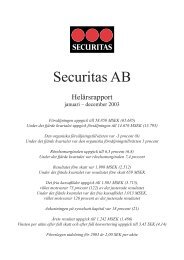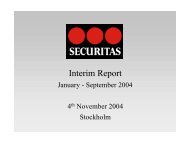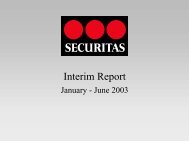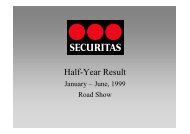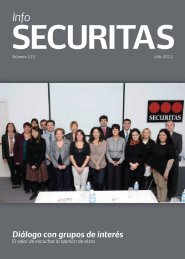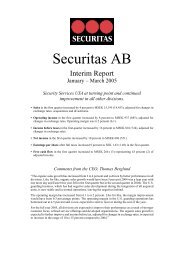Annual Report 2008 - Securitas
Annual Report 2008 - Securitas
Annual Report 2008 - Securitas
Create successful ePaper yourself
Turn your PDF publications into a flip-book with our unique Google optimized e-Paper software.
Employee benefits (IAS 19)<br />
The Group operates or participates in a number of defined benefit and defined<br />
contribution pension and other long-term employee benefit plans.<br />
Other plans primarily relate to healthcare benefits. A defined contribution<br />
plan is a pension plan under which the Group pays fixed contributions into<br />
a separate entity. The Group has no legal or constructive obligations to pay<br />
further contributions if the fund does not hold sufficient assets to pay all<br />
employees the benefits relating to employee service in the current and prior<br />
periods. Contributions are recognized as expenses when they fall due for<br />
payment. Other pension plans are defined benefit plans.<br />
Calculations for the defined benefit plans that exist within <strong>Securitas</strong> are<br />
carried out by independent actuaries. Costs for defined benefit plans are<br />
estimated using the so-called Projected Unit credit method in a way that<br />
distributes the cost over the employee’s working life. Obligations are valued<br />
at the present value of the expected future cash flows using a discount<br />
interest rate corresponding to the interest rate on high quality corporate<br />
bonds or government bonds with a remaining term that is approximately<br />
the same as the obligations. Further information regarding the determination<br />
of the discount rate is provided in Note 32. Plan assets are measured at fair<br />
value. The expected return on plan assets is determined as a weighted<br />
average of the expected long-term return for each of the asset categories in<br />
each plan. The return on equity related instruments is based on a risk premium<br />
that is added to a risk free return based on the yield of government bonds.<br />
The return on bonds is determined based on the yield of government and<br />
corporate bonds in accordance with each plan’s holding of these instruments.<br />
The Group has adopted the amendment to IAS 19 Employee Benefits as<br />
of January 1, 2006 regarding the principle for recognizing gains and losses<br />
resulting from changes in actuarial assumptions, plan experience and investment<br />
performance differing from that assumed. These actuarial gains<br />
and losses are for all defined benefit plans relating to post-employment<br />
benefits recognized in the period which they occur. Recognition is done via<br />
the statement of recognized income and expense on the line actuarial gains<br />
and losses net of tax. Actuarial gains and losses relating to defined benefit<br />
plans for other long-term employee benefits are recognized immediately<br />
via the statement of income.<br />
If accounting for a defined benefit plan results in a balance sheet asset,<br />
this is reported as a net asset in the consolidated balance sheet under other<br />
long-term receivables. Otherwise it is reported as a provision under provisions<br />
for pensions and similar commitments. Costs related to defined benefit<br />
plans, including the interest element, are recognized in operating income.<br />
Provisions for pensions and similar commitments are not included in net debt.<br />
Share-based payments (IFRS 2)<br />
IFrS 2 requires that the fair value of the equity settled schemes should be<br />
accounted for as an expense in the statement of income with the corresponding<br />
entry accounted for as equity. The expense should be accrued on<br />
a linear basis over the vesting period. For cash settled schemes IFrS 2 also<br />
requires that the fair value of the scheme should be recognized as an expense<br />
in the statement of income on a linear basis over the vesting period, but<br />
with the corresponding entry recognized as a liability rather than as equity.<br />
Furthermore if the incentive scheme lapses without settlement this will<br />
result in a reversal of the accrued cost for cash settled schemes only. For<br />
equity settled schemes no reversal will occur since no adjustment to the<br />
net assets is required.<br />
<strong>Securitas</strong> has no equity settled or cash settled schemes that would fall<br />
within the scope of this standard.<br />
Provisions (IAS 37)<br />
<strong>Annual</strong> report<br />
Notes and comments to the consolidated financial statements<br />
Provisions are recognized when the Group has a present obligation as a<br />
result of a past event and it is more probable than not that an outflow of<br />
resources embodying economic benefits will be required to settle the obligation<br />
and a reliable estimate can be made of the amount of the obligation.<br />
Provisions for restructuring are recognized when a detailed, formal plan for<br />
measures has been established and valid expectations have been raised by<br />
those affected by the measures. No provisions are recognized for future<br />
operating losses.<br />
claims reserves are calculated on the basis of a combination of case<br />
reserves, which represent claims reported, and IBNr (incurred but not<br />
reported) reserves. Actuarial calculations are performed quarterly to assess<br />
the adequacy of the reserves based on open claims and historical IBNr.<br />
<strong>Securitas</strong> <strong>Annual</strong> report <strong>2008</strong><br />
75




